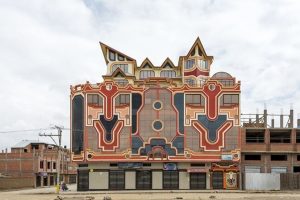(…architect Mamani doesn’t design his structures on a computer, preferring to either sketch on a wall or simply verbally explain ideas to his employees…)
Bolivian architect Freddy Mamani has established a New Andean architectural style, which is a contemporary architectural movement primarily situated in El Alto, Bolivia. Mamani has designed dozens of buildings for the wealthiest inhabitants of El Alto (population of roughly one million). Rooted in deep cultural motifs, these neo-futuristic buildings are characterized by strident colors and geometric figures. By outsiders to Andean culture have been described as “futuristic” and “funky” buildings.
About 120 such buildings exist across Bolivia, most in El Alto, and many more are under construction. Many architects in the region have begun to mimic Mamani’s style.
Mamani (and coincidentally, Bolivian President, Morales) is an Aymara, one of the nations of people native to the Andes and Altiplano regions of South America. His inspirations include Aymaran aguayos, a traditional textile whose bright colors and animal motifs have perhaps the clearest influence on his designs, as well as the chakana, or Andean cross, Incan ruins, ceramics, and sci-fi movies.
His buildings are so distinctive that they’ve got their own nickname: “cholets,” a portmanteau of the ethnic slur “cholo” and the Alpine architectural style “chalet.” By mixing various colors and adding many different lighting fixtures, the interior of the buildings can be just as bold and striking as the exterior.
Inside you’ll find dizzying shapes formed with plaster and rendered in Technicolor with oil paints, adorned with LED lights and chandeliers, and visually multiplied with mirrors. What’s even more head-spinning is that Mamani doesn’t design his structures on a computer, preferring to either sketch on a wall or simply verbally explain ideas to his employees.
Conquered first by the Incan empire and then by the Spanish, the region now known as Bolivia established its independence in 1825. Then 180 years later, in 2005, the country elected its first-ever president of indigenous descent, Evo Morales. That same year, Freddy Mamani designed his first building. Though not a formally trained architect – he was a bricklayer turned civil engineer – Mamani, in his mid-40s, has established the distinctive New Andean architectural style, which is characterized by a design vernacular that both reclaims cultural motifs and sends them hurtling into the future on buildings that have been likened to spaceships.
El Alto, in addition to being one of the highest cities in the world, overlooks the administrative capital of Bolivia, La Paz. It’s there that Morales worked to pass a new constitution in 2009 that legally affirmed the rights of the country’s indigenous cultures. Changes like that have helped transform Bolivia’s economy, sharply increasing the GDP and creating a burgeoning middle class.
[ Sources & References: Eric Allen, Architectural Digest, Elisabetta Andreoli, Getty, Paola Flores ]










